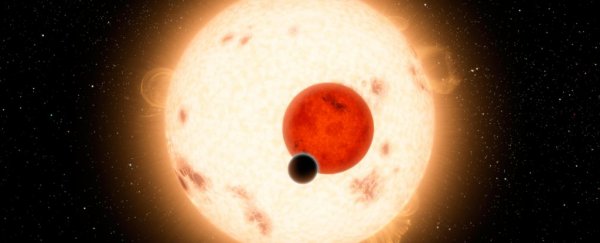Not all planetary systems are alike. Out there in the big, wide galaxy, a number of different configurations have been spotted, some vastly different from our home system. These include extrasolar planets, or exoplanets, that orbit not one, but two stars, like the fictional Star Wars world of Tatooine.
Now, for the first time, astronomers have been able to detect the tiny gravitational pull such an exoplanet exerts on one of its host stars, giving us a new tool to probe and explore these exotic worlds.
The exoplanet itself is not a new discovery. Its name is Kepler-16b, located 245 light-years away, and its discovery was announced in 2011.
It was hailed as the first confirmed, unambiguous detection of an exoplanet going around two stars in what we call a circumbinary orbit. As such, astronomers have looked at it a lot, and we know a lot about it.
This makes it perfect for trying something new – in astronomy, using a well-characterized and well-studied target is a good way to find out if techniques work.
In this case, a team led by astronomer Amaury Triaud of the University of Birmingham in the UK wanted to see if they could detect the planetary system through the wobble of one of its stars, a technique known as radial velocity.
"Kepler-16b was first discovered 10 years ago by NASA's Kepler satellite using the transit method," explained astronomer Alexandre Santerne of the University of Marseille in France.
"This system was the most unexpected discovery made by Kepler. We chose to turn our telescope and recover Kepler-16 to demonstrate the validity of our radial-velocity methods."
When we look for exoplanets, there are a number of different methods, but two are the most popular. By far the most prolific method is what we call the transit method. A space-based telescope will stare at a patch of the sky, looking for very faint, regular dips in starlight that indicate an exoplanet is passing between a star and us.
As mentioned earlier, the second-most fruitful method is the radial-velocity method, and this relies on the gravitational complexity of a planetary system. Stars, you see, are not fixed stationary objects, with exoplanets whirling around them. Each planet exerts its own gravitational influence on the star, causing the star to wobble a little, a bit like a discus thrower. The Sun does this too, influenced primarily by Jupiter.
This motion changes the observed light from the star. When the star moves away, the wavelengths stretch and increase slightly towards the red end of the spectrum; when it moves closer, the wavelengths compress and shift towards the blue end of the spectrum. Astronomers can use these changes to detect the presence of an orbiting exoplanet.
Previously, this had only been performed on single stars. Binary stars are a more complicated prospect; since they orbit each other, they have much larger motions through space, which makes the detection of the much smaller gravitational tug of any orbiting exoplanets more difficult.
To circumvent problems that arose from trying to disentangle the spectra of two bright stars, the team targeted a system with one bright star and one much fainter star. It worked. The 1.93-meter telescope at the Haute-Provence Observatory in France detected a radial velocity signal from the brighter of the two stars.
This can help us learn a lot. For one thing, radial velocity measurements show how much a star is moving, which can give astronomers accurate measurements of one of the key properties of an exoplanet – its mass.
The team's measurements showed that Kepler-16b is around a third of the mass of Jupiter, consistent with previous estimates.
In turn, this information could help us figure out how circumbinary worlds form, which is difficult to explain with current planet formation models. Around a single star, a disk of dust and gas called the protoplanetary disk – left over from the star's own formation – is thought to come together in clumps that form planets.
"Using this standard explanation it is difficult to understand how circumbinary planets can exist. That's because the presence of two stars interferes with the protoplanetary disk, and this prevents dust from agglomerating into planets, a process called accretion," Triaud explained.
"The planet may have formed far from the two stars, where their influence is weaker, and then moved inwards in a process called disk-driven migration – or, alternatively, we may find we need to revise our understanding of the process of planetary accretion."
More detailed information about the kinds of exoplanets in circumbinary (or even circumtrinary) orbits may help astronomers solve this problem. The team hopes that their work paves the way for future detections, and even discoveries, of circumbinary worlds.
The research has been published in the Monthly Notices of the Royal Astronomical Society.
